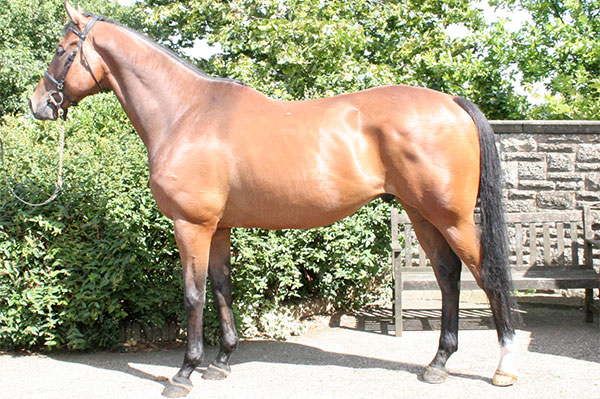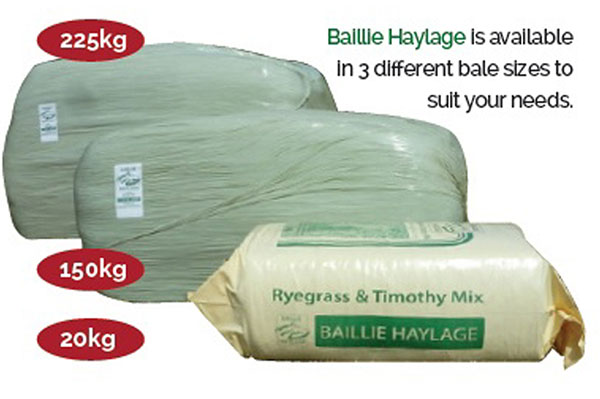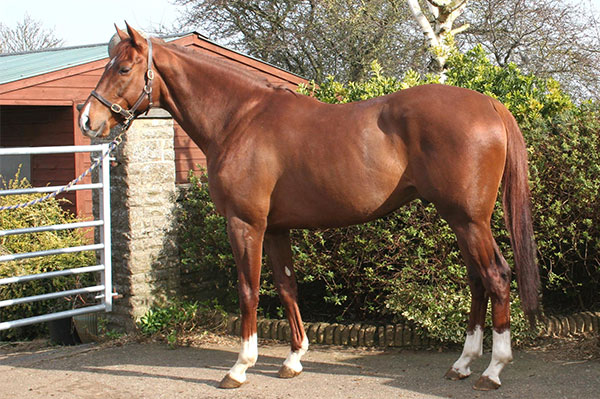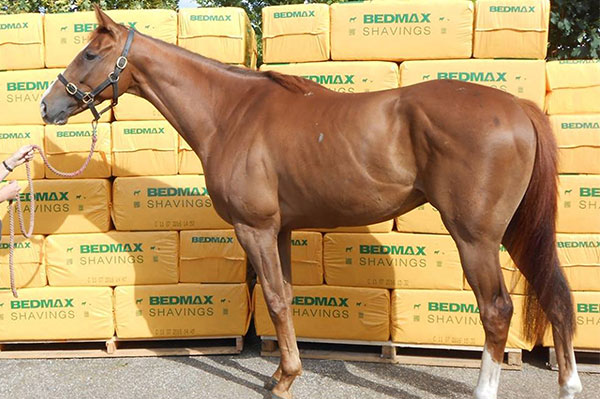In the first feature in a two part special on feeding an ex-racehorse, Fred & Rowena Cook look at a horse’s natural feeding habits, the basics of a horse’s diet and how to correctly feed an ex-racehorse.
Although Spillers introduced the first pelleted pony nuts in 1958, it was not until the late 1980’s that bagged mixes really began to hit the market. Up until this time feeding was so much more straightforward and there just didn’t seem to be the problems with colic and all the digestive ailments we see today. Horses were fed straights – bran, oats, barley, maize and linseed being the main ones – with hay being the forage. Horses also traditionally received a weekly bran mash.

A lovely healthy horse in great condition; the topline needs work and he needs to fill out but once properly developed he is going to be quite something!
With advances in food technology, the development of an ever increasing range of cubes and mixes, supplement and balances, it is little wonder that owners often don’t know what to feed for the best. Along with the advances seems to have come an increase in digestive ailments. Granted this is in-part to better diagnostics being available but we believe, rightly or wrongly, the use of so many agro-chemicals and even the inclusion in compound feeds of elements that a herbivore should not have, are contributory factors – despite there being a much better understanding these days of the need for the environment and management of a individual to be taken into consideration.
Nutrition has become such a specialist subject, but fortunately feed companies have their own in-house helplines to guide owners through the feeding maze. Of course you will be directed to use products from the company you have contacted so consulting with an independent nutritionist can be helpful to get you on the right track, then you go decide on which individual products would suit your horse.
The advent of bagged, nutritionally balanced feeds was meant to make life easier for horses owners, but walk into any feed store and there is such a huge range of feedstuffs available that it mind-boggling and so understandable that owners are as confused as ever about what to feed.
Part of the problem however is that owners remain tempted to feed ‘a bit of this’ and ‘a bit of that’; manufacturers are very clever in their marketing (and packaging), particularly where supplements are concerned virtually promising Olympic-medal performances if you feed their product(s); add to the mix – no pun intended – that people ask their friends what they feed, they ask on social media what everyone else is using, and end up giving quite concoction which is not suitable to their own horse although it all may look very appealing in the bucket.
The way nature designed the horse
When left to their own devices, horses will graze up to 18 hours a day eating up to 2-3% of their bodyweight. The digestive system of the horse efficiently processes large quantities of fibre in an almost non-stop way hence the term that horses are trickle-feeders. Because the horse has been designed to digest fibre in the hindgut, the stomach is very small and food passes through it very quickly. Despite this, horses constantly secrete stomach acid whether there is food available or not; hence why horses should have virtually limitless access to forage/fibre to stop harmful build- ups of this acid which can ulcerate the stomach lining. The horse actually has an in-built desire to chew and this again is down to nature as the constant chewing produces the all-important saliva that neutralises the harsh stomach acid before it enters the digestive tract proper.
It does seem a bit strange that the horse can breakdown and efficiently utilise such a tough and complex material as fibre, but it does, due to all the ‘friendly’ bacteria that live in the hindgut. These gut flora need the right environment in which to live and do their job, the horse needs them to keep his digestive system healthy and working to optimum levels so herein arises the situation whereby if the gut is not healthy, the bacteria are compromised, which can lead to digestive upsets and contribute to hindgut acidosis.
So let’s start at the beginning: the basics of the diet
The components of a balanced diet are:
Water – the source of life; whatever else is fed without water there is no life.
Dirty or stale water will deter adequate drinking so it is vital that horses always access to fresh water to encourage them to drink enough, as water is absolutely vital for healthy gut function. Hence in the winter months, field water troughs must be kept ice-free and horses offered water that has had the chill taken off it, as some will not drink very cold, icy water. This has lead to the production of a range of feeds that are soaked pre-feeding to make life easier for owners and take the worry away about enough water intake to keep the digestive system functioning properly. The water content mimics fresh grass but after the first growth flushes the water content reduces but this does not put the horse off eating the drier grass. So bear in mind that not every horse likes a wet feed or if he does eat it in the summer, he might not find it quite so appealing on a cold winter’s day unless of course you have used warm water! This of course is more readily done with the quick-soak feeds but a bit trickier for those that require several hours of soaking pre-feeding.
Fibre – vital for the digestive system; an excellent energy source.
Fibre, after water, remains the most important constituent of a horse’s diet. Forage provides the fibre that the horse digests and utilises so well; a constant supply of fibre keeps the gut healthy. Unless you opt to keep your horse out 24/7 it is just not feasible nor practicable to allow your horse to be out for so many hours a day. So it is important to try and mimic the trickle feeding as much as possible.
Protein – comprised of individual amino acids, protein is essential for the production of new body tissues and cell repair. Some amino acids play a larger role than others hence the term “quality protein” being applied to certain feedstuffs that contain more or higher levels of these amino acids. Protein is not the high-energy source some people think so it is not the cause of excitable behaviour.
Carbohydrates – sugars, starches and fibre provide energy for maintenance and for exercise. As starch and sugar are rapidly digested in the small intestine they release energy quickly, whereas fibre being digested in the hindgut energy is released more slowly.
Oil (fat) – excellent for healthy skin, coat and hooves as well as for the joints. Omega 3 is a valuable anti-inflammatory and a must for a horse with any signs of arthritis.
Vitamins – vital to support all the functions of the body. Some vitamins (the B complex and C) are water soluble so if fed in excess are flushed out of the body, but the rest (A, D, E and K) are fat soluble so are stored in the body thus fed in excess can disrupt bodily functions, which can lead to dry skin, cracking of the hooves, because the delicate interaction between vitamins and minerals is upset.
Minerals – macro minerals are those the horse needs more of such as calcium, phosphorus, magnesium and potassium whilst trace elements such as zinc, selenium, copper and manganese, whilst important, are required is lesser quantities.
Hay or haylage?
There is much debate over whether to feed hay or haylage. Of course with haylage there is better nutritional consistency than hay, which is much more dependent on the weather. And haylage can be produced to provide different levels of energy with ryegrass havlage being suitable for the hardworking/competition horse and timothy haylage being ideal for horses with a less active lifestyle, veterans and laminitics. When purchasing haylage, be sure to use a company which stamps the analysis on the bales so you know what you are feeding; you can send a hay sample for analysis so you know what are feeding – and that you are getting what you are paying for.

Baillie Haylage have a range of products to suit differing nutritional needs. Coming is bales or bags, the single and multiple horse owners can readily be catered for.
Balancers
The concept behind a balancer is “…. a nutrient-dense feed usually in pelleted form” is “…to combat nutrient deficiencies that may exist in the diet.” They provide vital vitamins and minerals for horses on forage and straights or compound (bagged) feed, not fed on the manufacturers recommended rate in the right ratio, so that vitamins and minerals can work correctly in sync with each other – yet horses given balancers still seem to have other supplements added – unnecessarily!
Owners often report weight gain of their horses when given a balancer; as balancers are very low in calories this is put down to the fact that the horse is now receiving a properly balanced, nutrient rich diet which optimally utilised. That they also contain prebiotics and/or probiotics further enhances gut health and so further promotes weight gain.
Prebiotics and probiotics
A prebiotic provides the friendly bacteria with a food source so that they can flourish and help to maintain the right gut environment. A probiotic is a yeast culture containing live yeast cells which helps to keep the environment in the gut healthy so that the friendly bacteria can work. YeaSacc1026 is one of the most popular yeast cultures. Probiotics improve the efficiency gut function enabling the horse to make the most of the foods he is being given; so going back to the comment above, if despite what you are feeding your horse does not look in such good shape as you would like then the diet is not suitably balanced (provided of course you are actually feeding him enough – and enough of the right foods.

First impressions are of a horse in good shape but he still is a little hollow in the flank and he is not quite right in his coat and across the rib cage. This is when experimentation with a balancer could be the best option in case he is lacking in any particular vits/mins.
Supplements
Apart from giving a balancer you should not give your horse additional supplements unless he has a proven need for it. This only serves to over-load the system and un-balance the delicate interaction of vits and mins. It is very fashionable to reel out a list of what you are giving you horse but very often it is not necessary and doing nothing but denting your bank balance.
Should it be decided that, for example, a joint supplement would help an arthritic horse, then check the label carefully to see what is actually in the supplement and whether ingredients are duplicated with what is being provided by the feed. This is why it is better to give a ‘pure‘ product rather than a pre-prepared combination. Some products also contain animal or marine by-products, which, fundamentally, doesn’t seem quite right when a horse would not naturally have access to such products if he were roaming free! But that of course is your decision.
Horses with stable vices
It is not uncommon for an ex-racehorse to present windsucking or cribbing. In the main, such behaviour will subside as the dietary and routine changes kick in. Such vices have long been attributed to boredom and/or the ‘racing diet’ of high carb, low fibre/forage feeds but there are horses that will continue to windsuck or crib despite having the most perfect management and lifestyle; as yet research can give no explanation why this should be so. If your horse turns out to have a habit, you can at least reduce the amount of time he is likely to do so by offering ad lib forage in a small-holed haynet; if this is not feasible then forage replacers can be useful in keeping both boredom and stomach acid at bay whilst helping to control the waistline.
Feeding the ex-racehorse
The diet you put together for your horse needs to not only provide him with the necessary nutrition for maintenance i.e. what is needed to keep him alive and functioning, but also to improve his bodyweight, build and maintain muscle and enable him to have the right levels of energy for the job you wish him to do.

The typical appearance of the fresh-out-of-training horse. We shall see how this horse has changed in another feature.
Generally the fresh out-of-training horse needs to lose his racing muscle that is gradually replaced by riding horse muscle and of course build up bodyweight and condition; he no longer requires a ‘rocket fuel‘ diet.
New owners are invariably keen to improve the appearance of their horse as quickly as possible and in their eagerness to do so often over-face the horse with a myriad of different feeds, in their quest to turn their change into the equine equivalent of Arnold Schwarzenegger overnight.
This is wrong approach; everyone knows that new feeds should be introduced gradually; this is so that the delicate balances of good bacteria in the gut is not disturbed and so digestive disturbances are avoided. Owners expect their horse to go ‘cold turkey’ and accept and instant change of diet and pack on the pounds within a week.
Whilst the high energy hard feed that the horse was used to can be exchanged for lower energy foods, adding increased amounts of fibre and forage can be a little more problematic as the racehorse is not used to consuming the larger amounts that we like to feed the riding horse. These days, racehorses do have access to more fibre and indeed forage than they ever used to it, it still remains a lesser amount than is ideal for the horse and the way nature has designed him to eat and digest food.
Factors that influence what to feed:
Compiling the diet
Amount to feed:
When deciding on quantity remember that a minimum of 1% of the horse’s bodyweight should be fed as forage; thus a 500Kg horse should have 5Kg of hay/haylage minimum per day. If there are reasons why a horse should not have this quantity. then hay replacers can be fed such as chaffs/fibre feeds and dried grasses.
Fred and Rowena Cook
The next part of this series will put feeding theory into action with a range of different scenarios.
Thoroughbred Training Consultants – Equine Management and Training
Inc Rehoming Racehorses – A Life After Racing
RoR Approved Racehorse Retrainers
Retraining Consultants to Greatwood Charity
UK Agents: Ardall Equine & Rider Safety System
Authors: “Re-Educating Racehorses – A Life After Racing”
To find your own ex-racehorse, please visit Source an Ex-Racehorse